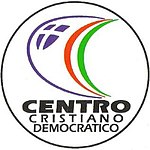Christian Democratic Centre
This article needs additional citations for verification. (August 2012) |
Christian Democratic Centre Centro Cristiano Democratico | |
|---|---|
 | |
| Leader | Pier Ferdinando Casini |
| Founded | 18 January 1994 |
| Dissolved | 6 December 2002 |
| Split from | Christian Democracy |
| Merged into | Union of Christian and Centre Democrats |
| Headquarters | Rome, Italy |
| Ideology | Christian democracy |
| Political position | Centre-right[1] |
| National affiliation | Pole of Freedoms/Pole of Good Government (1994), Pole for Freedoms (1996-2001), House of Freedoms (2001-02) |
| European affiliation | European People's Party |
| European Parliament group | European People's Party |
| International affiliation | Christian Democrat International |
The Christian Democratic Centre (Template:Lang-it, CCD) was a Christian democratic[2] political party in Italy.
The CCD was a member of the European People's Party (EPP) from 1994 to 2002.[3]
History
The party emerged from a split from Italian People's Party (PPI), the direct heir of the Christian Democracy (DC), in 1994.[4][5] Its leaders were Pier Ferdinando Casini and Clemente Mastella who advocated an alliance with Silvio Berlusconi's Forza Italia (FI), while the PPI advocated a centrist alliance with the Segni Pact called Pact for Italy. The CCD represented the right wing of the old DC,[6] while the PPI was largely the heir of the party's left wing, especially after the split of the United Christian Democrats (CDU) in 1995.
In the 1994 general election the CCD joined FI as a member of the Pole of Freedoms in Northern Italy and the Pole of Good Government in Southern Italy,[7] forming a joint list with FI for the proportional system and gaining 27 deputies and 12 senators. After the election the CCD joined the Berlusconi I Cabinet, with Clemente Mastella becoming Minister of Labour and Francesco D'Onofrio Minister of Education.
After the sudden fall of Berlusconi's first government on 2 December 1994, when Lega Nord left the government majority, a new general election took place in 1996. The CCD formed a joint list with the CDU. The alliance proved successful, gaining 5.8% of the vote, 30 deputies and 15 senators, however, as the centre-right lost the election to The Olive Tree centre-left coalition, the party remained into opposition.
In 1998 Clemente Mastella and several other MPs left the party to form, along with the CDU, the Democratic Union for the Republic (UDR), which supported the centre-left government. In 1999 the UDR was transformed into the Union of Democrats for Europe (UDEUR) and the CDU re-organised themselves as a party, returning to the alliance with the CCD.
Once again CCD and CDU formed a joint list (the White Flower) for the 2001 general election, this time gaining only 3.2% of the vote, as part of the winning House of Freedoms coalition composed mainly of Forza Italia, the National Alliance and Lega Nord. In 2002 the CCD, the CDU and European Democracy (DE) formally merged into one party, the Union of Christian and Centre Democrats (UDC).
Leadership
- Secretary: Pier Ferdinando Casini (1994–2001), Marco Follini (2001–2002)
- President: Clemente Mastella (1994–1998), Sandro Fontana (1998–2002)
- Party Leader in the Chamber of Deputies: Carlo Giovanardi (1994–1998), Marco Follini (1998–2001)
- Party Leader in the Senate: Massimo Palombi (1994–1996), Francesco D'Onofrio (1996–2001)
- Party Leader in the European Parliament: Sandro Fontana (1994–1999), Raffaele Lombardo (1999–2004)
References
- ^ Isabella Pezzini (2001). "Advertising politics on television: the party election broadcast". In Luciano Chelos; Lucio Sponza (eds.). The Art of Persuasion: Political Communication in Italy from 1945 to the 1990s. Manchester University Press. pp. 187–188. ISBN 978-0-7190-4170-9.
- ^ Ari-Veikko Anttiroiko; Matti Mälkiä, eds. (2007). Encyclopedia of Digital Government. Idea Group Inc (IGI). p. 396. ISBN 978-1-59140-790-4.
- ^ Thomas Jansen; Steven Van Hecke (2011). At Europe's Service: The Origins and Evolution of the European People's Party. Springer. p. 51. ISBN 978-3-642-19413-9. Retrieved 19 August 2012.
- ^ Luciano Bardi; Piero Ignazi (1998). Piero Ignazi; Colette Ysmal (eds.). The Organization of Political Parties in Southern Europe. Greenwood Publishing Group. p. 102. ISBN 978-0-275-95612-7.
- ^ Daniela Giannetti; Bernard Grofman (2011). "Appendix D". A Natural Experiment on Electoral Law Reform: Evaluating the Long Run Consequences of 1990s Electoral Reform in Italy and Japan. Springer Science & Business Media. p. 131. ISBN 978-1-4419-7228-6.
- ^ La Civiltà cattolica. La Civiltà Cattolica. 1994. p. 179. UOM:39015085064908.
